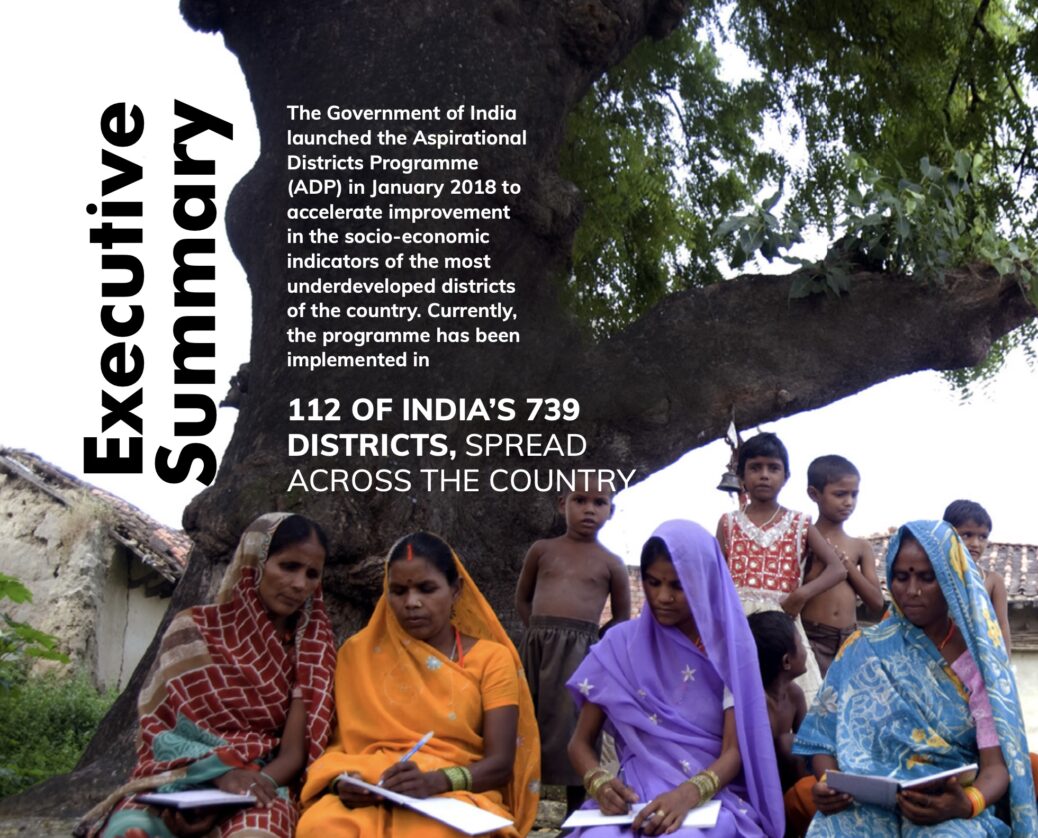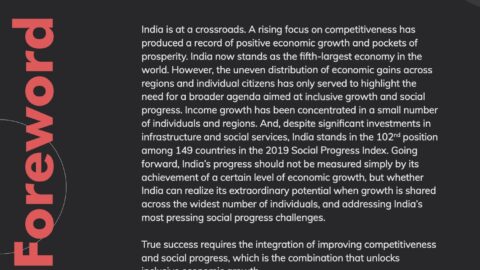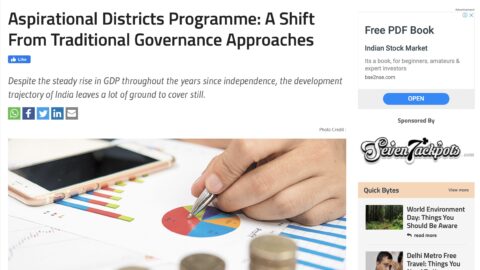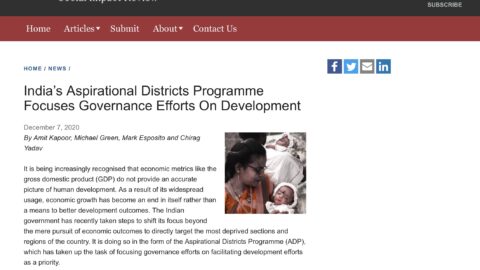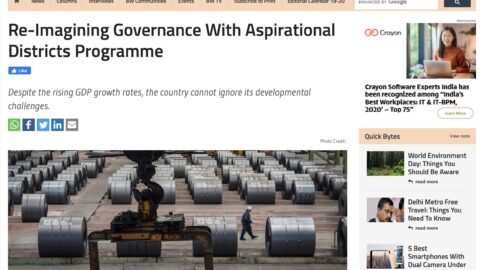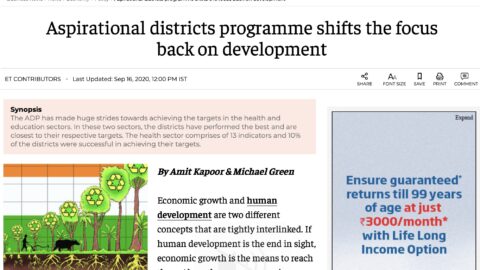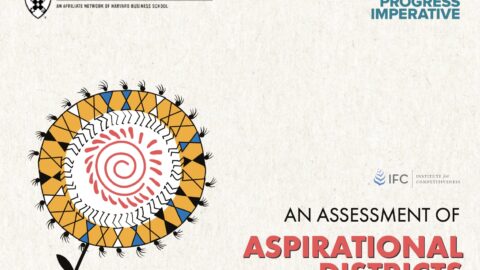The Government of India launched the Aspirational Districts Programme (ADP) in January 2018 to accelerate improvement in the socio-economic indicators of the most underdeveloped districts in the country. Currently, the programme has been implemented in 112 of India’s 739 districts, spread across the country.
The ADP is a collective effort. At the Central level, NITI Aayog is anchoring the program and individual Ministries have assumed responsibilities to drive the progress of the districts. Yet it is the state governments that are the main drivers of change. Each state has formed a committee under their respective Chief Secretaries to implement as well as track the programme. Moreover, for each district, a central Prabhari Officer of the rank of Additional Secretary/Joint Secretary has been appointed to provide feedback and recommendations based on their local level findings.
The research in this study documents the social development outcomes in some of the most challenging regions of India. It examines institutional best practices, coordination frameworks across government bodies and other partners, and governance and leadership initiatives at the district level which can be used to replicate the success of this initiative not only in other districts of India, but also in other countries facing similar socio-economic challenges.
We find that there are several ways by which the project contributes towards enhancing the social progress of the region.
- First, by measuring the current state of various social parameters and highlighting the most pressing issues, the programme acknowledges that focusing solely on economic parameters won’t lead to inclusive development in India. Moreover, these social challenges might hamper future economic growth as well.
- Second, by focusing on underdeveloped pockets of India it will help in addressing the issue of regional disparities.
- Third, by embedding partners within the institutional rubric of the government and encouraging them to integrate with the district administration instead of them functioning as external practitioners of development, the programme adopts a unique approach that can lead to maximum social and human development.
The assessment of the programme reveals insights that can provide direction to the programme leaders and implementing agencies about future focus areas; it can help in unlocking the full potential of the programme and can provide guidance for replicating the programmes across different geographies.
- Disparities across sectors are high
ADP covers 5 sectors: Health & Nutrition, Education, Agriculture & Water Resources, Financial Inclusion & Skill Development, and Basic Infrastructure. Within each sector, there are indicators and the targets are set for each of these indicators. We observe significant sectoral disparities across the TAPD programme in progress towards these targets (see Figure 1):
- Health and Education are the sectors in which the districts are closest to achieving their targets. In health, the maximum distance of districts away from their targets is about 30 percent.
- Agriculture and Financial Inclusion are the main areas of concern for most aspirational districts as their average scores lie farthest away from the frontier. Most of the districts are 40-90 percent away from their targets.

This analysis suggests that areas such as Agriculture and Water Resources, Financial Inclusion, Skill Development require greater attention in the TAPD programme going forward.
The disparities can be also be seen by looking at a particular district. The figure below depicts the performance of Dohad across sectors. It has overachieved its target in Health and Nutrition and lags behind its targets by significant margins in Agriculture and Water Resources, Skill Development and Financial Inclusion. These results suggest that there are no clear achievers or laggards across sectors.

- Concrete best practices are emerging from the programme
Three key areas of best practice have emerged from the TAPD programme:
- Awareness: several districts have used awareness campaigns to reach out to populations which have been detached from the development process. Raising awareness campaigns help create a common platform for engagement, thereby helping with the integration of actors and beneficiaries.
- Collaboration: ADP incentivises collaboration between tiers and agencies of government and with the private and civil society sectors. By leveraging assets and networks in a collective effort, ADP enhances the outreach capacity of the district administration in integrating the population.
- Data-based interventions: the use of data to measure impact, locate nodes for improvement, as well as to identify policies and interventions that are driving the most change is critical to the success of ADP.
- ADP is generating economic as well as social impact
This study also sheds light on the economic benefits that the country can derive by addressing the social challenges. In health and nutrition, for example, the economic impact of reducing Severe Acute Malnutrition (SAM) among children is felt through the effects on productivity and lifetime learning. The overall economic impact for all the states (only looking at Aspirational Districts) of reducing SAM is estimated to be a mammoth 1.43 Lakh Crores. Similarly, the impact of providing household latrines is around 400 crores INR. These economic benefits can provide a strong rationale for the government in investing in programmes directed towards social benefits.
- Streamlining data collection and ensuring effective feedback loop to update programmes based on relevant data insights is critical
There is significant diversity among the districts covered by ADP. The indicators of the programme also range from inputs through to outcomes. This suggests two opportunities to enhance data collection and analysis:
- Survey methods should be adjusted to reflect the fact that not all ADP indicators show change at similar frequency. Output and outcome indicators that show change over the long-run should be assessed on an annual basis, while short-run input indicators can continue to be assessed on a quarterly basis. This would also improve survey reliability. Moreover, it would help ADP leaders to streamline the chosen group of indicators that form the basis of competition among the aspirational districts. For example, indicators like percentage of pregnant women taking nutrition and those having severe anaemia treated are heavily correlated (0.89); it would be ideal to resolve such duplication of assessment.
- The study shows that districts that are at different levels progress at different rates. For example, districts at are lower level that are catching up will be able to progress faster than the most advanced districts. Therefore, it is suggested that districts are divided into peer groups based on their level of development, to facilitate relevant lesson sharing.

